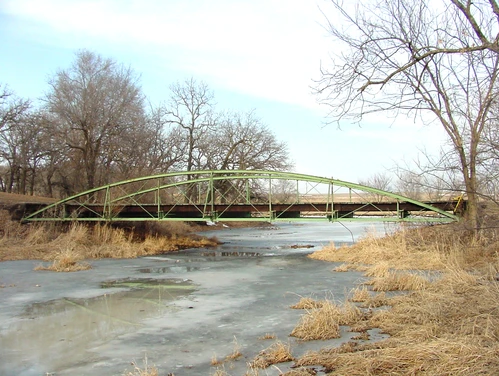- Year constructed: 1876
- Alternate name: Nodaway River Bridge, Pilot Grove County Park Bridge
- Bridge type: Bowstring Pony Arch-Truss
- National Register of Historic Places status: Listed
- Length: 70 feet
- Width: 14 feet
- Spans: 1
- Jurisdiction: Montgomery Conservation and Parks
- Location: Pedestrian path in Pilot Grove County Park, 3 miles west of Grant, Section 1, T73N-R37W (Pilot Grove Township)
Details
In January 1876, the Montgomery County Board of Supervisors received a petition from S.M. Smith and others for a new bridge over the Nodaway River south of Grant. The board at first laid the petition aside, but reconsidered it late that year. In June the board ordered the construction of a 70-foot iron span at this point, along with a 100-foot iron span over the Nishnabotna River and another bridge across Seven Mile Creek. A month later, the supervisors awarded contracts for the Nishnabotna and Nodaway river bridges t, the former to the Canton Bridge Company for $1,975 and the latter to the Missouri Valley Bridge and Iron Works for $1,000. The Leavenworth, Kansas firm fabricated a bowstring arch-truss and erected it that year. With its laced channel upper chords, iron bar lower chords and star iron verticals and outriders, the Nodaway River Bridge typified Missouri Valley standard bridge design of the period. The small-scale structure carried vehicular traffic until I was moved to Pilot Grove County Park around 1968. It now carries pedestrian traffic over the arm of a small pond.
The bowstring arch-truss was the iron span of choice for Iowa counties in the late 1860s and 1870s. Marketed extensively by such industry giants as the Wrought Iron Bridge Company and King Iron Bridge and Manufacturing Company of Ohio, and the Missouri Valley Bridge and Iron Company of Kansas, these often-patented bridge forms featured a wide range of span lengths, economical fabrication cost and relatively quick erection. The proliferation of the bowstring corresponded with the initial development of Iowa's road system, and as a result, perhaps thousands of these prototypical iron spans were erected throughout the state. The bowstring design had some rather severe structural flaws, however, and it was superseded by the pin-connected truss in the early 1880s. Through subsequent attrition, almost all of Iowa's bowstrings have since been replaced and demolished. Although it no longer functions as designed in its original location, the Nodaway River Bridge is a historically and technologically significant resource in the interpretation of early Iowa transportation development.
Adapted from Fraser 1991
Areas Served
- Montgomery
